14 Best Tuscan Foods To Try in 2025
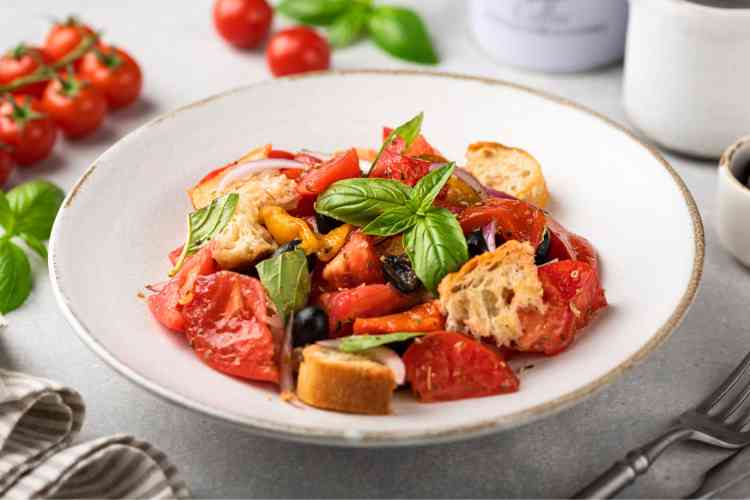
At its core, Tuscan food celebrates simplicity, tradition and the seasonal flavors of the region. From the lush, green hills of Chianti to the bustling back alleys of Florence, there are always more wines to drink and more dishes to taste in Tuscany.
Is it the ingredients, the techniques or the communal nature that makes Tuscany, Italy food so beloved around the world? Or perhaps all three?
Whether you're savoring a tender bistecca alla Fiorentina or dipping crunchy cantucci into a glass of vin santo, every dish within Tuscan food tells a story of the land, its people and their deep connection to the ingredients used. In this article, we’ll explore some of the most popular dishes that make Tuscan cuisine truly unforgettable.
Jump to Section
What Food Is Tuscany Known For?
Tuscan food is a reflection of the region’s landscape, history and love for simple, high-quality ingredients. This culinary identity celebrated fresh produce, artisan techniques and a "farm-to-table" ethos long before it became trendy.
The food of Tuscany, Italy, includes hearty soups like ribollita — made with kale, cannellini beans and stale bread — as well as rich pasta dishes like pappardelle al ragù di Cinghiale — featuring a slow-cooked wild boar sauce — among many other types of dishes.
Being on the coast with multiple port cities, seafood also plays a prominent role in Tuscan food with dishes like cacciucco, a robust fish stew, one of the most popular. Meat centerpieces are also common on many Tuscan food menus, including the tender, chargrilled bistecca alla Fiorentina and offal-based specialties like lampredotto, which are staples of the inland areas. Tuscan meals often end on a sweet note with desserts like cantucci or torta della nonna, a creamy pine nut tart.
With centuries-old culinary traditions and a rich agricultural heritage, it’s no wonder that Tuscany is brimming with such a diverse array of dishes. And with Italian food being one of the most popular cuisines in the world according to sources like Statista, it's not surprising that people are looking to learn more about (and taste) regional foods, such as the best Tuscan dishes.
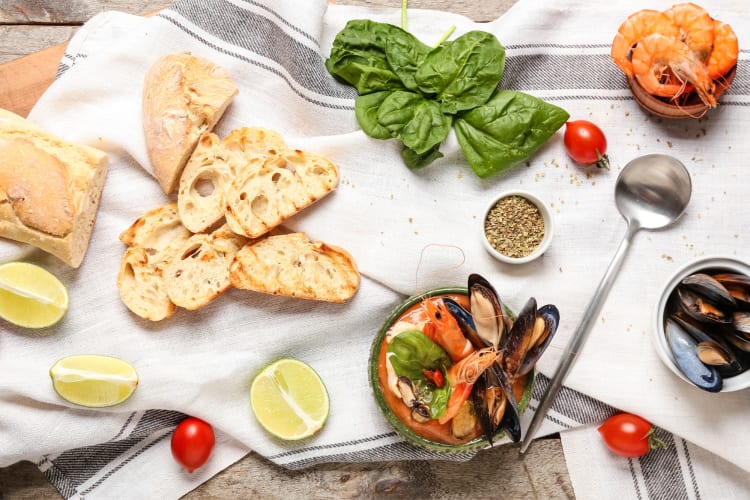
The 14 Best Foods of Tuscany, Italy
1. Pappa al Pomodoro
Showcasing simplicity, pappa al pomodoro is one of the most cherished Tuscan foods, and it mirrors the region's ability to turn humble ingredients into a show-stopping culinary delight. This thick, tomato-based soup — a must-try for any foodie bucket list — is made by stewing ripe tomatoes with garlic, basil, olive oil and stale bread, which absorbs the liquid and creates a thick, creamy and porridge-like texture.
The dish embodies the Tuscan tradition of wasting nothing, transforming leftover ingredients into a flavorful comfort food. Pappa al pomodoro is often served in family-run trattorias and cozy cafés, where it arrives warm, garnished with a drizzle of high-quality olive oil and sometimes a sprig of fresh basil.
Though the flavors of this Tuscan food are simple, the dish is deeply satisfying and equally enjoyable as a standalone meal or paired with grilled meats. Its enduring popularity highlights the resourcefulness and warmth that define Tuscan food.
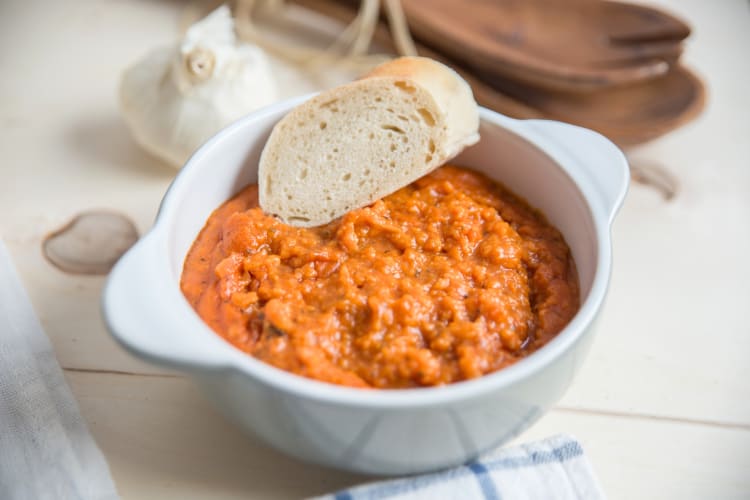
2. Bistecca alla Fiorentina
Bistecca alla Fiorentina is an iconic Tuscan food that is loved for its simplicity and unparalleled flavor. This dish showcases a thick, succulent T-bone steak made from Chianina beef, a prized cattle breed native to Tuscany.
The preparation is straightforward but precise: the steak is flash-grilled over hot coals and seasoned with just salt and pepper, plus a drizzle of olive oil, allowing the natural flavors of the high-quality meat to shine.
Tradition dictates that bistecca alla Fiorentina is served rare, which highlights its tender texture and juiciness. This dish is often presented raw before cooking to show off the delicate veins of fat, its freshness and unmatched quality, a testament to its cultural significance.
Typically enjoyed in Florence, one of the world's best foodie cities, this iconic dish is a highlight in both high-end restaurants and rustic trattorias. It pairs beautifully with robust red wines like Chianti or brunello di Montalcino, enhancing the dish's rich flavors. Some restaurants may serve this Florence food with a side of roasted potatoes or seasonal vegetables, though the steak itself remains the star.

3. Torta di Ceci
Also known as cecina or farinata, torta di ceci is a thin, crispy pancake made from chickpea flour. This vegan and gluten-free Tuscan food is crafted with a simple batter of chickpea flour, water, olive oil and salt, which is left to rest before being baked in a wood-fired oven. The result is a golden, savory pancake with a soft center and crisp edges.
Popular in coastal towns like Livorno, torta di ceci is often served as a street food snack or appetizer. Sometimes enjoyed plain or with a sprinkle of rosemary, this Tuscan food can also be paired with grilled vegetables or used as a filling in sandwiches. This versatile dish showcases the ingenuity of Tuscany, Italy food in creating flavorful meals from simple ingredients.
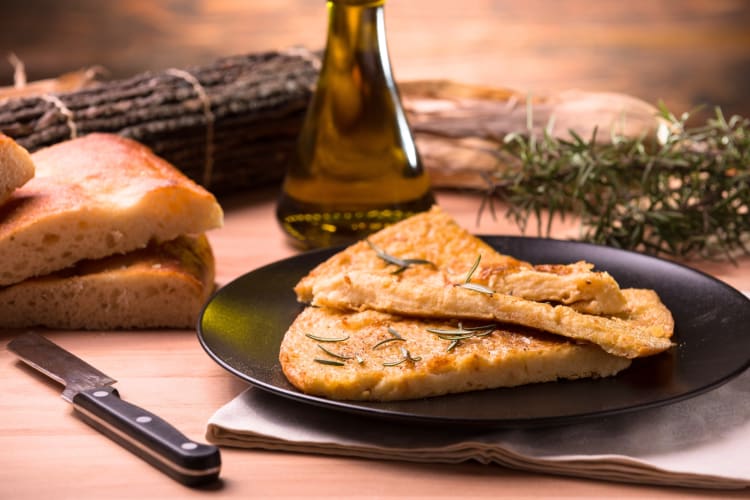
4. Cacciucco
Hailing from the coastal town of Livorno in Tuscany, Italy, cacciucco is a hearty and flavorful fish stew that is a treasure of the region's cuisine. This dish combines a medley of seafood like mussels, clams, squid and white fish with a tomato-based broth containing garlic, white wine and olive oil.
Traditionally, it includes at least five types of fish, symbolizing the five "Cs" in its name and stale bread is often used to thicken the stew; a hallmark of Tuscany's resourceful cooking traditions.
This comforting dish is a staple in seafood restaurants along the Tuscan coast, where the catch of the day determines its ingredients. The bold flavors of cacciucco are complemented by a side of toasted bread — which serves to soak up the rich, briny broth — and it’s often rubbed with garlic for extra flavor. Variations may include spicier broths or the addition of small crustaceans but the essence of cacciucco remains deeply rooted in Tuscan food heritage.

5. Cantucci
Cantucci are small, twice-baked almond biscuits that have become synonymous with Tuscan food culture and are similar to biscotti. These crunchy delights are traditionally served with vin santo, a sweet dessert wine that softens the biscuits and accentuates the nutty flavor.
Made from simple ingredients like flour, sugar, eggs and whole almonds, cantucci are baked into logs before being sliced and baked again to achieve their characteristic crunch.
Available in bakeries and cafés throughout Tuscany, cantucci are often enjoyed as a dessert or an afternoon snack. Modern variations might include chocolate chips or hazelnuts but the classic almond version remains the most popular. Dipping these biscuits into vin santo is a ritual that shows the simple yet refined pleasures of Tuscan food.
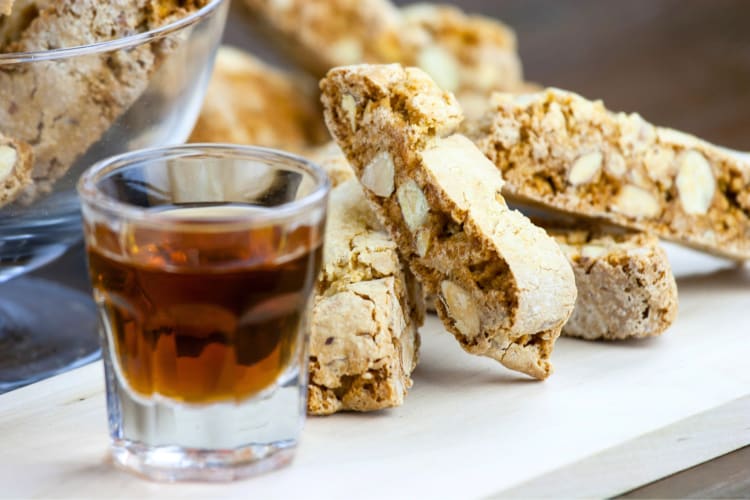
6. Crostini al Fegatini
A Tuscan food staple, crostini al fegatini features toasted bread topped with a rich chicken liver pâté. The pâté is typically flavored with anchovy paste, capers, garlic and fresh herbs and the result is a creamy and savory spread. This dish is an essential part of the Tuscan antipasto course and reflects the region's skill in using every part of an ingredient.
Served in traditional trattorias and upscale restaurants alike, crostini al fegatini is a popular appetizer that pairs wonderfully with a glass of Chianti. While variations of the pâté may include brandy or lemon zest, the classic recipe remains a quintessential introduction to Tuscany's robust flavors.
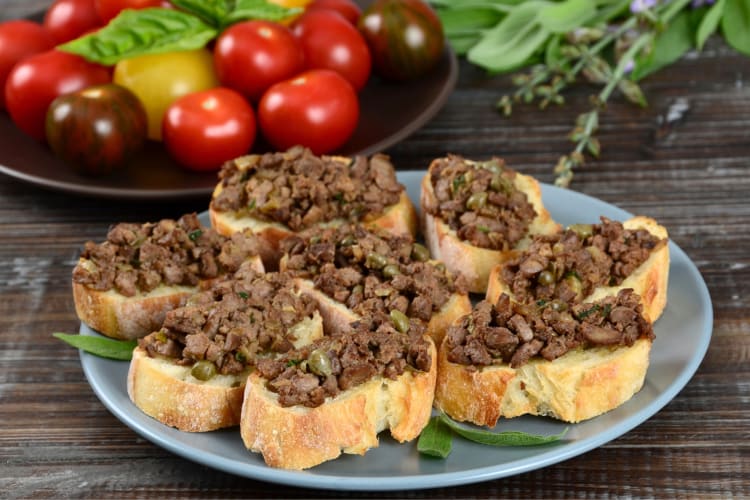
7. Castagnaccio
Castagnaccio is a rustic chestnut flour cake that embodies the earthy flavors of Tuscan food. This dense, gluten-free dessert is made with chestnut flour, water and olive oil and is often enriched with pine nuts, raisins and rosemary.
The result is a slightly sweet, moist cake with a unique nutty flavor. Traditionally, it was a staple during the chestnut harvest season when chestnuts were a vital food source for Tuscan communities.
This humble cake is a favorite in Tuscany food establishments like bakeries and cafés, particularly during autumn festivals celebrating chestnuts. Served warm or at room temperature, castagnaccio pairs well with a glass of vin santo or a strong espresso and its simplicity connects it to Tuscany's agricultural history, making it a dish steeped in tradition.
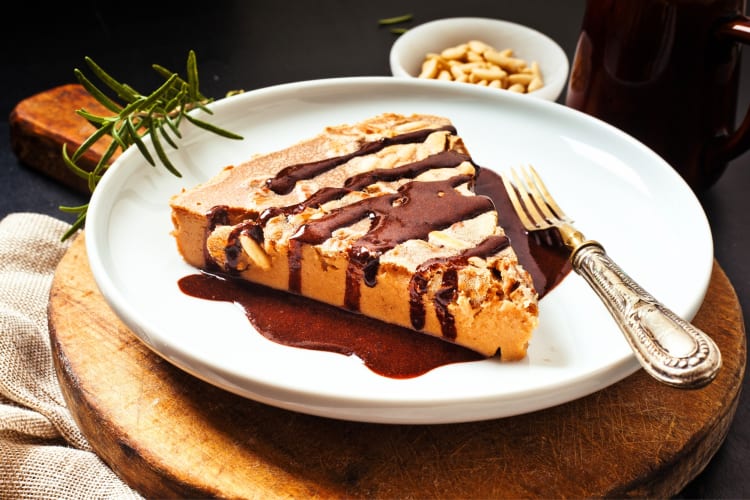
8. Fagioli all’uccelletto
Fagioli all’uccelletto is a comforting bean dish that is simple and hearty. The cannellini beans are slow-cooked with tomatoes, sage, garlic and olive oil and the result is a flavorful and aromatic side dish that is a key component in any Tuscan food spread for first-timers. Despite its humble ingredients, this dish is deeply satisfying and a staple of peasant Tuscan cuisine.
Often served alongside grilled meats or sausages or on its own with a crusty slice of bread, fagioli all’uccelletto is a favorite in family-run trattorias. Its rustic charm and focus on the quality of Tuscan olive oil make it a beloved accompaniment to many regional dishes.
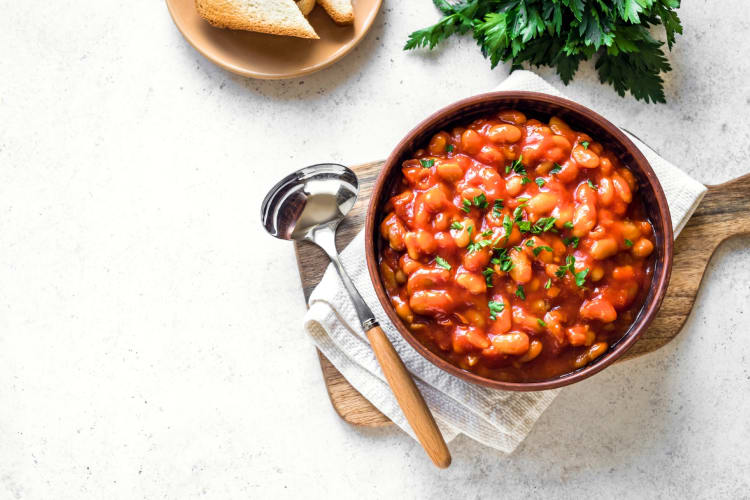
9. Lampredotto
An iconic Tuscan food and a must-try street food in Florence, lampredotto is made from the cow's fourth stomach. This dish is simmered in a seasoned broth until tender and then served in a sandwich with salsa verde and black pepper. Its bold flavors and unique texture have made it a favorite among locals and foodie tourists alike.
Available at street stalls and casual eateries, lampredotto is a quintessential taste of Florence. It is often enjoyed as a quick lunch or late-night snack, showcasing the region's love for utilizing every part of an ingredient.

10. Pappardelle al Ragù di Cinghiale
Pappardelle al ragù di cinghiale is a quintessential example of hearty Tuscan food, marrying wide ribbons of handmade pasta with a deeply flavorful wild boar ragù. The dish begins with the slow cooking of wild boar meat, which is marinated overnight in a mix of red wine, garlic, juniper berries and herbs to tenderize it and infuse it with flavor.
The ragù is then simmered with tomatoes, onions and aromatic herbs until it reaches a rich, velvety consistency. The pappardelle, with its broad, flat shape, is the perfect vessel for capturing this delicious sauce.
Variations may include the addition of porcini mushrooms for an earthy depth or a touch of chile for subtle heat. Pappardelle al ragù di cinghiale is typically accompanied by a glass of Chianti or another full-bodied Tuscan red wine, enhancing the bold flavors of this rustic delicacy.
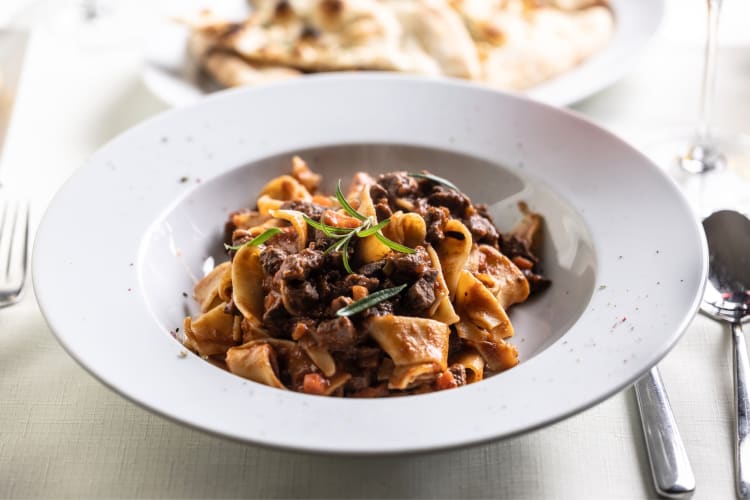
11. Panzanella
One of the most well-known Tuscan foods out there, panzanella is vibrant and refreshing, truly capturing the essence of summer. This rustic salad combines chunks of stale bread soaked in water and vinegar with ripe tomatoes, red onions or shallots and fresh basil.
A generous drizzle of olive oil ties the ingredients together, creating a dish that is both light and bursting with flavor. Even the umami-packed juice from the tomatoes is used to make the irresistible dressing and the bread soaks up every last drop.
Often enjoyed as a light lunch or side dish during the hot months, panzanella is a common Tuscan food feature in casual eateries and at picnics. Variations might include capers, tuna or olives for an added twist but the core elements remain unchanged. Its simplicity makes it a quintessential representation of Tuscan culinary ingenuity.
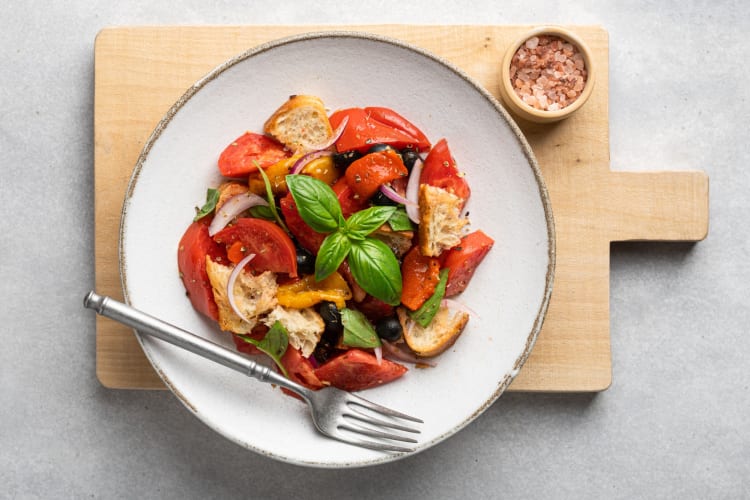
12. Ribollita
Ribollita, meaning "re-boiled," is a beloved traditional Tuscan food. This thick soup was born from the peasant practice of reheating vegetable stew with stale bread to create a hearty, nourishing meal.
Key ingredients include cannellini beans, kale (often the Tuscan variety known as cavolo nero), carrots, celery and onions. The soup is simmered slowly, allowing the flavors to meld and the bread to thicken it to a stew-like consistency.
Commonly served in trattorias during the colder months, ribollita is a warming comfort meal that speaks to the heart of Tuscan food. Each bowl is typically garnished with a drizzle of extra-virgin olive oil and a sprinkle of freshly ground black pepper.
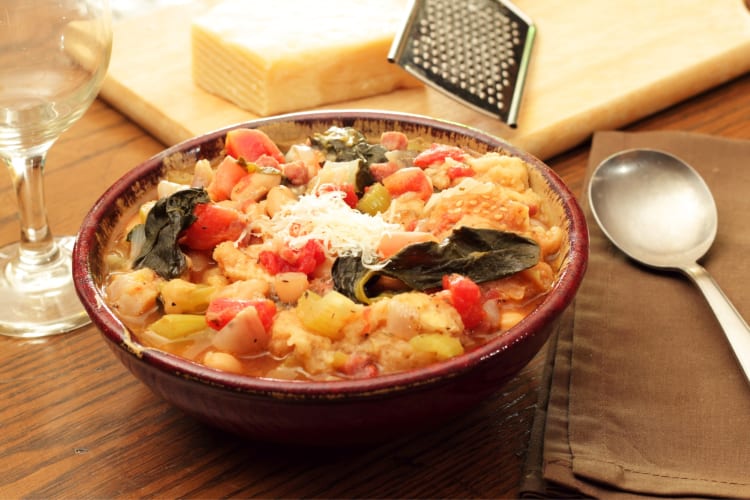
13. Schiacciata
Schiacciata is a Tuscan food that takes on different forms depending on the season and occasion. The savory version, known as schiacciata salata, is a flatbread brushed with olive oil and sprinkled with coarse salt, often enjoyed as a snack or used to make sandwiches.
Its slightly chewy texture and crisp crust make it a great accompaniment to cured meats and cheeses. During the grape harvest, a sweet variation called schiacciata all'uva emerges, featuring juicy grapes baked into the dough with sugar and rosemary.
Schiacciata alla Fiorentina, a third variation, is a sweet cake traditionally served during Carnival. Made with eggs and often filled with cream, this version is light and airy, dusted with powdered sugar and sometimes adorned with the Florentine lily. Whether savory or sweet, schiacciata is a delightful treat that showcases the breadth of flavors in Tuscan food.
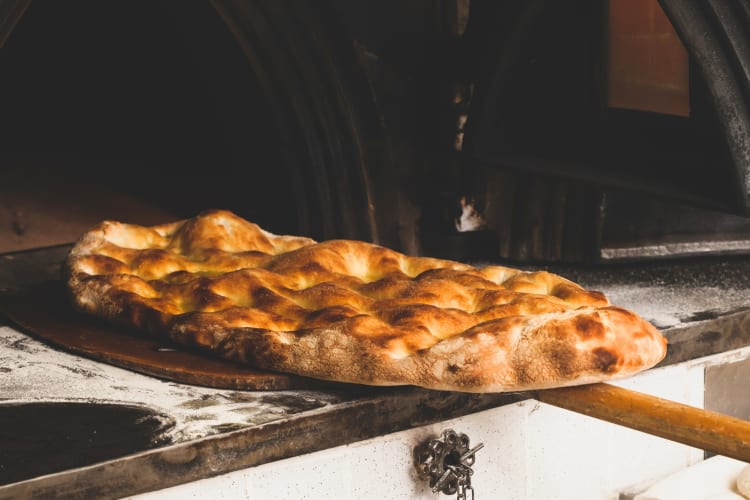
14. Torta della Nonna
Translating to "grandmother's cake," torta della nonna is a Tuscan food that exemplifies the region's love for simple yet indulgent flavors. This shortcrust tart is filled with a rich custard made from eggs, sugar, milk and lemon zest, then topped with pine nuts and powdered sugar.
The contrast between the crisp pastry and creamy filling creates a perfect harmony, and its simplicity makes it a favorite amongst nonnas at home and bakers in cafés alike. Though its name suggests homestyle origins, torta della nonna was reportedly invented by a chef in Florence and it quickly became a classic Tuscan food across the region.
Variations may include a hint of vanilla or a chocolate-flavored filling but the traditional version remains the most popular. Often served with a cup of coffee or a glass of vin santo, this timeless dessert is a fitting end to any Tuscan meal.

Learn To Cook Tuscan Food
If you’ve ever dreamed of bringing the taste of Tuscan food to your own table, cooking classes in Tuscany are a perfect way to immerse yourself in the region's culinary traditions. These classes often take place in picturesque villas or rustic kitchens, where expert chefs guide you through crafting dishes like pappardelle al ragù di cinghiale or ribollita using fresh, local ingredients.
Can't make it to Italy? No problem. You can also learn to prepare Tuscan food and all your other favorite Italian dishes with cooking classes near you or online cooking classes. These options let you explore the flavors of Tuscan food from the comfort of your own kitchen, making it easier than ever to learn about this cherished cuisine.

Tuscan food is more than just sustenance; it’s a celebration of heritage, resourcefulness and the joy of sharing meals with loved ones. Whether you’re indulging in a hearty stew-like cacciucco or savoring the sweet simplicity of torta della nonna, every dish is a testament to the timeless allure of this region's culinary traditions.
For even more ways to explore your favorite foods, check out other experiences happening on Cozymeal.



FOOD FOR THOUGHT?
Join the conversation.